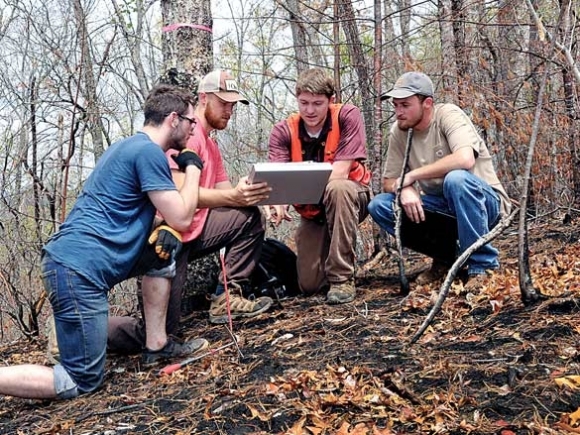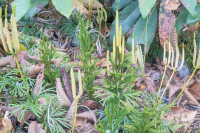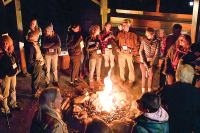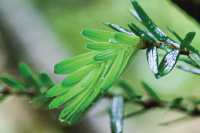Wildfires as classrooms: WCU students study fire’s effects on Dicks Creek drainage

What was once a wildfire became an outdoor classroom for students in Western Carolina University’s Natural Resource Conservation and Management Program this spring.
As part of a spring capstone course, 23 students studied four post-fire aspects of the forest ecosystem — forest composition, wildlife habitat, soil and water. Now, they’ve just finished compiling and analyzing the data they gleaned from the 728-acre burned area of the Dicks Creek drainage near Dillsboro.
“Every year, we want our students to have a chance to work on a real natural resource management problem,” said Peter Bates, associate professor in the program. “Given the fall fire season that we had and the proximity of the Dick’s Creek fire, we thought this would provide a good opportunity to study the potential effects of the fire. The students draw on things they’ve learned throughout the curriculum, so it is a good test.”
The wildfires that roared through Western North Carolina last fall certainly constituted a “real natural resource management problem.” Fueled by a drought that had been building since the spring, the fires were mostly set by arsonists, land managers believe. With the mountains tinder-dry, the fires quickly spread to engulf nearly 50,000 acres of national forest land west of Asheville, with tens of thousands more burning east of Asheville and in the Great Smoky Mountains National Park into Tennessee.
The Dicks Creek Fire was at the front end of all that, however, with its Oct. 23 ignition making it the first major wildfire to appear west of Asheville last fall. And even when the wildfire season subsided, it stood alone as the closest major woodland blaze to WCU.
Fire is a natural part of any forest ecosystem, and evidence of the Dicks Creek Fire — as with all the other wildfires that burned through the region — will slowly subside over time. While charcoal may exist in the soil for thousands of years, most casual observers won’t be able to see the signs after three to seven years, though changes to the plant community could last for much longer.
Related Items
To study the fire’s effects, students separated into small groups to gather data, complete geospatial mapping and prepare the final report. They also collaborated with the U.S. Forest Service, N.C. Forest Service and N.C. Wildlife Resources Commission.
“Faculty members monitored what was done, but it was very much a student project,” Bates said.
Students established 40 permanent plots in the burn area, documenting the conditions that exist there now and developing a monitoring plan to determine the fire’s evolving effects as time goes by.
The students did a particularly good job of mapping the fire’s severity, which is a function of how hot it burned, Bates said. That factor will be important to consider when calculating the fire’s effects in future years. Fire severity is determined by examining features such as how much rhododendron and mountain laurel was consumed, measuring how high the char marks are on trees and determining how much ground litter and duff was consumed, he said.
Wildfires are typically cooler and slower when going downhill, but faster and hotter when moving uphill. And in the eastern U.S., they tend to mostly creep along the ground, burning up leaf litter and sometimes consuming larger fuels as the fire heats up. However, the Dicks Creek fire sometimes behaved more like a fire typical of the arid forests of the American West, turning into a canopy-consuming crown fire as it raced up ridges.
While they can be dangerous to human communities and any animals trapped in the blaze, wildfires can also have a rejuvenating effect on forest ecosystems once the flames are gone, spurring growth of leafy plants that provide food for wildlife. Abbi Farnsworth, who graduated this spring, examined the fire’s effects on wildlife as part of her research. Farnsworth and the students she worked with placed motion-activated cameras in the plots. When something moved, the cameras took two still photos and a short video clip — the result was 120 days’ worth of camera data.
“So far, the most interesting thing we found is that animals like one extreme or the other — they like the high-severity burn areas or the unburned areas, but they don’t like the moderate areas,” Farnsworth said.
Hunter Combs, who will graduate in December, focused on studying the condition of the soils — in particular, how well water could infiltrate them. Intense fires can cause soils to repel water, due to the burning leaves leaving their waxy coating behind. That can cause erosion.
The good news is that, according to Combs’ data, erosion doesn’t appear to be a serious issue in the Dicks Creek area.
“The infiltration was extremely variable,” Combs said. “Erosion didn’t seem to be a problem. The intensely burned sites tended to have a little more erosion, but we didn’t see any extreme erosion or gully formation.”
The data will be collected into a digital archive that will be available for future reference.













